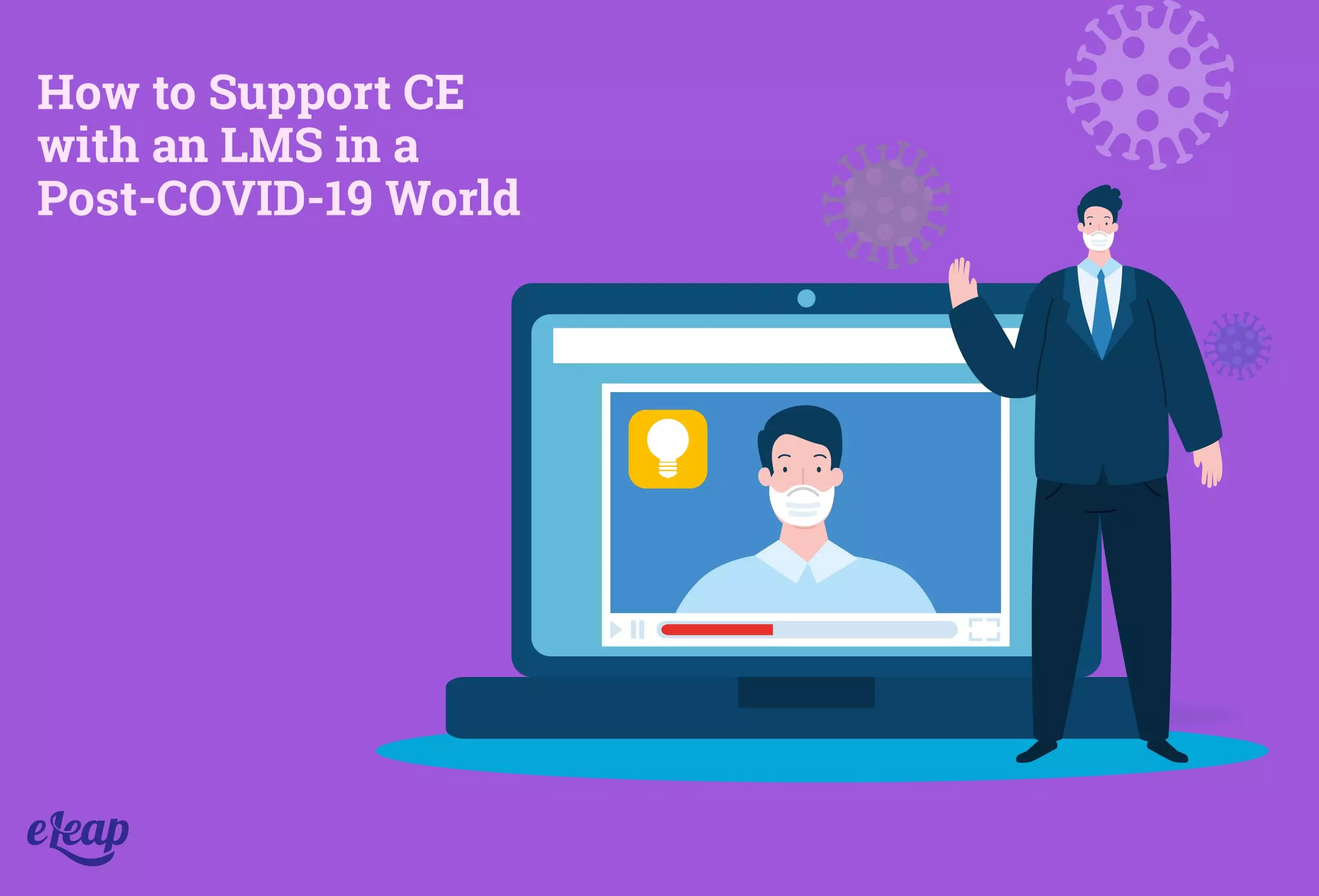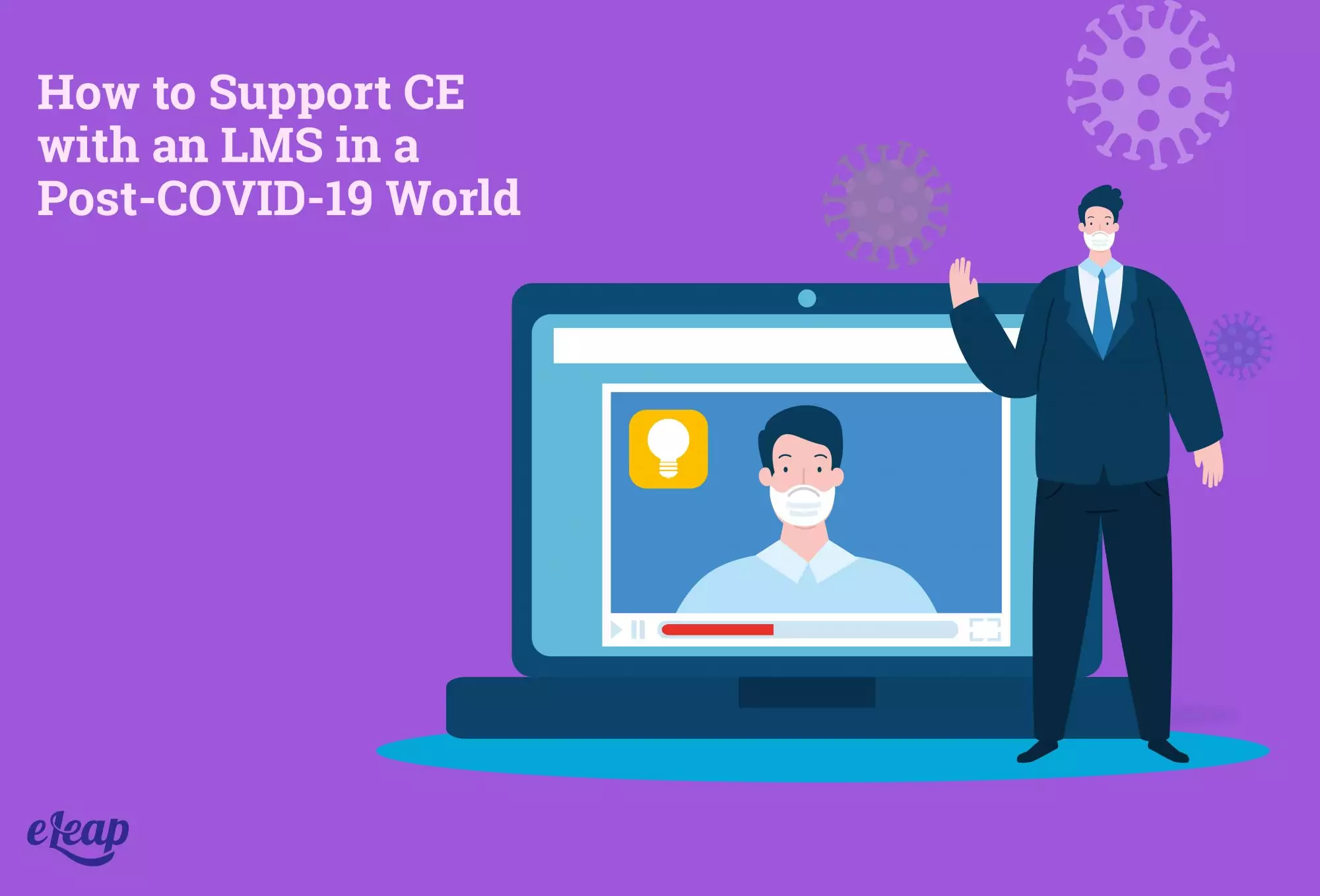How to Support CE with an LMS in a Post-COVID-19 World

Continuing education, or CE, is a critical consideration for professionals and organizations around the world. Without the required number of credit hours, these professionals may lose their license or certification. Without access to training, they may also fall behind in terms of the knowledge and skills required to perform their jobs correctly.
However, COVID-19 has made it challenging for organizations to support CE in traditional ways. The good news is that a learning management system can provide training and education within your organization.

Online Distance Learning Rather Than Instructor-Led Courses
An LMS provides the flexibility to move to online distance learning, rather than in a traditional classroom setting. However, this can be a difficult shift for those who aren’t used to the digital environment and for organizations that haven’t digitized their training materials.
There are several things to consider here. First, make sure that you understand which professionals require CE, as opposed to mandatory corporate training or voluntary development training. Next, make sure you have a good understanding of what training is required for these professionals. You can often verify this by checking the content of instructor-led classes. Finally, you need to either digitize instructor-led content or use existing digital content that covers the same topics.
Make It Available
Once you have determined who needs CE and have found a way to deliver it through your LMS, the next step is to make it available to your learners. Because they will be completing these courses from remote locations, thinking beyond face-to-face interaction is important. Content can be created in-house or by using pre-existing content. Some of the methods that work well include:
- Webinars – For an authentic classroom-like experience in a distance learning environment, nothing beats a webinar. These platforms allow you to host dozens or even hundreds of learners at one time. Most platforms also include tools that allow learners to ask questions and get answers from the instructor to ensure they’re able to absorb the information correctly.
- Video – Video lessons provide a very similar experience to instructor-led, classroom-based learning, but in a digital format. There are lots of video platforms that can be used, depending on whether you want live streaming video or to use prerecorded video. Some options include YouTube and Vimeo, but there are numerous others.
- Web Conferencing – Your learners must have at least some ability to discuss things with one another. Collaborative learning is highly beneficial, and remote learning does not need to mean it’s impossible. With web conferencing tools like Zoom, Microsoft Teams, and others out there, it is simpler than ever for your learners to communicate with and learn from one another.
- Test Creation – It’s not enough to provide learners with access to information pertinent to their CE. They also need to retain that information. The best way to ensure that they are retaining it is to test them. In most situations, professionals will need to take a formal test to comply with CE mandates, but it’s best if you test beforehand. This provides the ability to go back and refresh in areas where a learner may not have absorbed the information correctly. The LMS you choose should have the ability to create mock tests and quizzes to support information retention ahead of the official test.
LMS Features That Play Key Roles
While making CE content available is a critical consideration, you also need to make sure that your LMS is up to the task. With more and more professionals completing their CE requirements from home, these features have never been more crucial.
- Management Tools – Make sure that your learners have access to course management tools. This should provide the ability to track their progress toward key milestone completion, but also much more. How easily does your LMS make it for learners to track their progress, retake lessons, or identify areas they need to improve?
- Integration with Other Technology – A wide range of software and hardware is used in today’s organizations. Make sure that your LMS plays well with others. It should support easy integration with other tools that your learners might need to use, such as Zoom and FreshBooks, for instance.
- Mobile-Friendly – You cannot expect your learners to always use a desktop or laptop computer. More and more people today rely on mobile technology as their primary option outside the workplace. For instance, more people are accessing the Internet from their mobile phones today than from their desktops. The same trend applies to tablets. However, if your LMS isn’t mobile-friendly, you’re adding hurdles to the process and making it more difficult for your learners to complete their lessons.
- Global Delivery – More organizations than ever before employ people in geographically diverse locations. That might be across an entire nation, or within multiple nations. This is a critical consideration when it comes to CE, particularly in the wake of COVID-19, when most professionals cannot come together in large groups, such as in a classroom. Make sure that your LMS provides the ability to localize content, transforming information into something that is perfectly adapted for other languages and cultures.
Conclusion: COVID-19 Doesn’t Have to Mean Difficulties Completing CE
While it might seem like the socially-distanced world we inhabit makes completing CE problematic, the truth is, you can ensure your learners have access to all the information and tools they need. However, this does require that you act with intentionality. You must create an ideal LMS to support a culture of learning. To make sure that professionals within your organization have access to the courses, classes, and information they need to prepare themselves.
In addition to supporting CE, the right LMS can also help ensure that you can complete mandatory corporate training, handle onboarding needs, and provide your team with the ability to complete voluntary professional development courses, all while remaining safely socially distanced.